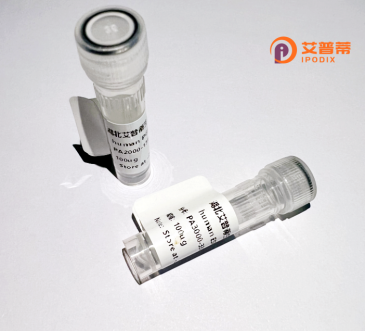
| 纯度 | >90%SDS-PAGE. |
| 种属 | Human |
| 靶点 | GAPDS |
| Uniprot No | O14556 |
| 内毒素 | < 0.01EU/μg |
| 表达宿主 | E.coli |
| 表达区间 | 1-408aa |
| 氨基酸序列 | MSKRDIVLTNVTVVQLLRQPCPVTRAPPPPEPKAEVEPQPQPEPTPVREEIKPPPPPLPPHPATPPPKMVSVARELTVGINGFGRIGRLVLRACMEKGVKVVAVNDPFIDPEYMVYMFKYDSTHGRYKGSVEFRNGQLVVDNHEISVYQCKEPKQIPWRAVGSPYVVESTGVYLSIQAASDHISAGAQRVVISAPSPDAPMFVMGVNENDYNPGSMNIVSNASCTTNCLAPLAKVIHERFGIVEGLMTTVHSYTATQKTVDGPSRKAWRDGRGAHQNIIPASTGAAKAVTKVIPELKGKLTGMAFRVPTPDVSVVDLTCRLAQPAPYSAIKEAVKAAAKGPMAGILAYTEDEVVSTDFLGDTHSSIFDAKAGIALNDNFVKLISWYDNEYGYSHRVVDLLRYMFSRDK |
| 分子量 | 70.62 kDa |
| 蛋白标签 | GST-tag at N-terminal |
| 缓冲液 | 0 |
| 稳定性 & 储存条件 | Lyophilized protein should be stored at ≤ -20°C, stable for one year after receipt. Reconstituted protein solution can be stored at 2-8°C for 2-7 days. Aliquots of reconstituted samples are stable at ≤ -20°C for 3 months. |
| 复溶 | Always centrifuge tubes before opening.Do not mix by vortex or pipetting. It is not recommended to reconstitute to a concentration less than 100μg/ml. Dissolve the lyophilized protein in distilled water. Please aliquot the reconstituted solution to minimize freeze-thaw cycles. |
以下为3-4篇关于重组人GAPDS蛋白的相关文献概览(信息基于公开发表的研究整理):
---
1. **文献名称**:Crystal structure of human sperm-specific glyceraldehyde-3-phosphate dehydrogenase (GAPDHS)
**作者**:Shiba K, et al.
**摘要**:研究解析了重组表达的人GAPDS蛋白晶体结构,揭示了其与普通GAPDH的结构差异,尤其在高活性催化位点和精子特异性功能区的关键特征,为理解精子能量代谢机制提供结构基础。
---
2. **文献名称**:Role of GAPDHS in human sperm motility and male infertility
**作者**:Guerriero G, et al.
**摘要**:通过重组表达GAPDS蛋白,研究发现其在精子运动中的关键作用,并证实某些男性不育患者的GAPDS基因突变会导致酶活性下降,提出GAPDS可作为临床诊断的潜在标志物。
---
3. **文献名称**:Localization and functional analysis of recombinant GAPDS in mammalian sperm
**作者**:Bunch S, et al.
**摘要**:利用重组GAPDS蛋白进行免疫定位研究,发现其特异分布于精子尾部主段,通过敲除实验证明该蛋白对精子尾部能量供应和运动能力不可或缺。
---
4. **文献名称**:Proteomic characterization of sperm-specific proteins using recombinant GAPDS as a biomarker
**作者**:Kristic J, et al.
**摘要**:研究通过重组GAPDS建立标准化检测方法,结合蛋白质组学分析,验证了GAPDS在精子成熟过程中的动态表达变化及其与其他代谢蛋白的相互作用网络。
---
如需具体文献的全文链接或补充信息,建议通过PubMed或Web of Science检索对应标题获取。
Glyceraldehyde-3-phosphate dehydrogenase-Spermatogenic (GAPDS) is a testis-specific isoform of the glycolytic enzyme GAPDH, primarily expressed in mammalian sperm cells. Unlike ubiquitously expressed GAPDH, GAPDS features unique structural adaptations, including an extended N-terminal region and a C-terminal extension, which facilitate its localization to the fibrous sheath of sperm flagella. This spatial positioning is critical for its dual role in energy production and sperm motility regulation during fertilization.
GAPDS catalyzes the sixth step of glycolysis, converting glyceraldehyde-3-phosphate to 1.3-bisphosphoglycerate while reducing NAD⁺ to NADH. Its spermatogenic specialization enables ATP generation within sperm’s energy-demanding flagellum, essential for maintaining motility and fertilization capacity. Recombinant human GAPDS protein is typically produced in bacterial (e.g., *E. coli*) or eukaryotic expression systems, retaining enzymatic activity for functional studies.
Research highlights its diagnostic potential in male infertility, as abnormal GAPDS expression correlates with reduced sperm motility. Emerging studies also implicate GAPDS in non-glycolytic pathways, including redox regulation and interaction with signaling molecules, suggesting broader roles in cellular homeostasis. Furthermore, its immunogenicity in some infertility cases positions it as a target for contraceptive vaccine development. Recent investigations explore its ectopic expression in cancers, though mechanisms remain unclear.
Characterization of recombinant GAPDS continues to advance reproductive biology and therapeutic discovery, bridging fundamental biochemistry with clinical applications.
×